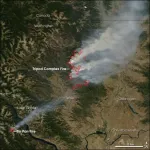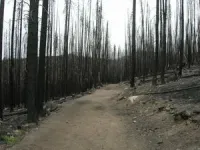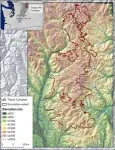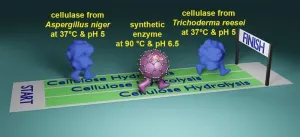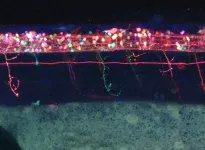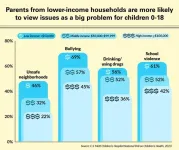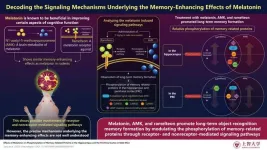University of Washington
206-543-2580
jurton@uw.edu
(Note: researcher contact information at the end)
For Immediate Release
August 21, 2023
In 2006, the Tripod Complex Fire burned more than 175,000 acres in north-central Washington. The fire, which was within the Okanogan-Wenatchee National Forest, was more than three times the size of Seattle. Yet while considered severe at the time, even larger wildfires in 2014, 2015 and 2021 have since dwarfed Tripod.
Past research shows that large and severe wildfires like these were much rarer in the western U.S. and Canada prior to the late 20th century.
“Fire exclusion policies for much of the 20th century yielded many dense forests with largely uniform composition,” said Susan Prichard, a research scientist with the UW School of Environmental and Forest Sciences. “By the turn of this century, we had mature and densely treed, multi-layered forests with high fuel content — and as a result, large, destructive wildfires can ignite and spread more easily. There’s simply more to burn across large landscapes.”
Prichard, along with colleagues from the U.S. Forest Service’s Pacific Northwest Research Station — Paul Hessburg, Nicholas Povak and Brion Salter — and consulting fire ecologist Robert Gray, have created a modeling tool that will allow managers and policymakers to imagine and realize a different future: one where large, severe wildfires like Tripod are once again rare events, even under climate change.
The tool, known as REBURN, can simulate large forest landscapes and wildfire dynamics over decades or centuries under different wildfire management strategies. The model can simulate the consequences of extinguishing all wildfires regardless of size, which was done for much of the 20th century, or of allowing certain fires to return to uninhabited areas. REBURN can also simulate conditions where more benign forest landscape dynamics have fully recovered in an area.
In a pair of papers published June 30 and July 31 in the journal Fire Ecology, the team applied REBURN to the region in north-central Washington where the 2006 Tripod Complex Fire burned. Simulations showed that setting prescribed burns and allowing smaller wildfires to burn can yield more varied and resilient forests over time. Such forests are made up of forest condition “patches” of different sizes and shapes, and all at different stages of recovery from their most recent fire. Patches that recently burned acted as “fences” to the flow of fire for at least the next 5 to 15 years, preventing wildfires from spreading widely. REBURN simulations showed that a forest landscape comprised of 35 to 50% “fence” areas had far fewer large-scale and damaging wildfires.
“Landscapes had tipped to more ‘benign’ burning conditions,” said Hessburg.
REBURN simulations showed that, when fence areas were less abundant across a region, larger and more severe wildfires tended to dominate how the landscape developed over time.
“The model allows us to simulate what can happen when different management scenarios are applied before the fact, including how small or medium-sized fires in uninhabited areas can reshape forest vulnerability to fires,” said Prichard. “We found that having a more complex forest environment — in terms of tree age, composition, density, fuel content — makes it harder for large fires to spread and become severe.”
“We also found that non-forest areas comprised of grasslands, shrublands, wet and dry meadows, and sparsely treed woodlands were key ingredients of wildfire-resilient forests,” said Hessburg. “REBURN showed us that our policy of extinguishing all wildfires created forests like those that exist today, with large, severe wildfires growing more prevalent. In addition to destroying homes and blanketing cities and towns with smoke, conflagrations like these displace wildlife, destroy habitats, and can burn large areas severely, sometimes making it difficult for forests to return.”
Short intervals between forest reburns can be especially harmful for long-term recovery by destroying young trees that have not yet produced cones, they added.
From 1940 to 2005 in Washington’s North Cascades, fire crews extinguished more than 300 fires in their early stages in the Tripod area — most triggered by lightning strikes. By the 1980s and 1990s, forests in the region had become high-density tinderboxes, loaded with older, dying trees and lots of dead wood and other fuel on the ground.
Research has shown that before large-scale European colonization of the area, smaller wildfires shaped forests in north-central Washington and elsewhere in the Pacific Northwest. The Methow people and other tribes in the region actively set fires through cultural burning practices. Aerial photos show that, as recently as the 1930s, forests in north-central Washington had a “patchwork quilt” structure that kept large wildfires from forming easily.
“Forests with more complex structure — including densely and lightly treed areas like meadows and grasslands, shrublands, and spare woodlands — also create a wider variety of habitats for wildlife,” Hessburg said. “Recently burned areas can develop into wet or dry meadows that can host deer or moose. Other, younger tree-dense areas can host lynx and snowshoe hares.”
REBURN can be adapted to other regions in the western U.S. and Canada. Prichard, Hessburg and their colleagues are currently adapting it to simulate forest development in the vast forests of southern British Columbia and northern California, including regions recently hit by wildfires and those culturally burned by Indigenous people.
But knowing when — or even whether — to allow a small fire to burn in an uninhabited region is no easy task, since fire managers must protect people, their homes and livelihoods. The team hopes ongoing research will help refine the model and the insight it can provide to modified forest management strategies.
“This is a new type of tool that couples forest and non-forest development models over time, fuel fall-down after fires, and a fire growth model,” said Hessburg.
“We hope that it will help people who make major decisions about our forests understand the long-term consequences of different practices and policies when it comes to wildfires,” said Prichard. “We hope it will make these conversations easier to have by grounding our predictions in sound forest science.”
The research was funded by the Joint Fire Science Program and the U.S. Forest Service Pacific Northwest Research Station.
###
For more information, contact Prichard at 509-341-4493 and sprich@uw.edu and Hessburg at 509-423-6738 and paul.hessburg@usda.gov.
Grant number: JFSP 14-1-02-30
Name pronunciation guide:
Susan Prichard: SU-san PRICH-urd
Paul Hessburg: Pol HES-burg
END
